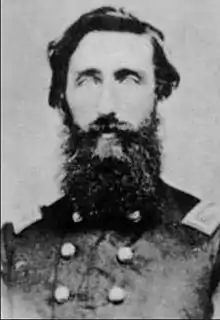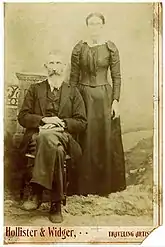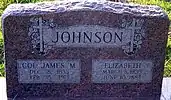James M. Johnson (politician)
James M. Johnson (December 8, 1832 – February 15, 1913) was an Arkansas politician. He was an officer in the Union Army; commanding the 1st Arkansas Infantry Regiment (Union) during the American Civil War and becoming a brevet brigadier general.[1] His younger half-brother Robert S. Johnson died while serving as a private in the 16th Kansas Cavalry in Dakota Territory during the summer of 1865.
Colonel James M. Johnson | |
|---|---|
 James M. Johnson during the Civil War | |
| 2nd Lieutenant Governor of Arkansas | |
| In office 1868–1871 | |
| Governor | Powell Clayton |
| Preceded by | Calvin Bliss |
| Succeeded by | Volney V. Smith |
| 10th Secretary of State of Arkansas | |
| In office 1871–1874 | |
| Governor | Ozra Amander Hadley Elisha Baxter |
| Preceded by | Robert J. T. White |
| Succeeded by | Benton B. Beavers |
| Personal details | |
| Born | December 8, 1832 Warren County, Tennessee |
| Died | February 15, 1913 (aged 80) Madison County, Arkansas |
| Political party | Brindle Tail Republican |
| Spouse(s) | Elizabeth Johnson (m. 1850; died 1883) Jennie A. Mullins (m.1893) |
| Children | 7 |
| Profession | Farmer, Physician, Soldier, Politician |
| Military service | |
| Allegiance | |
| Branch/service | United States Volunteers |
| Years of service | 1863-65 |
| Rank | |
| Commands | 1st Arkansas Infantry Regiment 1st Brigade, 3rd Division of VII Corps Department of Arkansas |
| Battles/wars | American Civil War
|
Early life and education
James Madison Johnson was born in Warren County, Tennessee on December 8, 1832. In 1836 his family moved to Madison county, Arkansas where he attended college in Fayetteville and at the Ozark institute. On September 10, 1850 he married a cousin, Elizabeth Johnson. The couple had 7 children.
He became farmer until 1855 when he switched to learning medicine at Fayetteville. In 1857 he studied at St. Louis School of Medicine until 1858, upon returning to Arkansas in 1859 he opened his own medical practice in Huntsville, Arkansas that lasted until 1862.[2]
Civil War
Johnson was a known Unionist and he, along with his brother frank and fellow Unionist and friend Isaac Murphy, left to join the Union army that was under the command of General Samuel Curtis in Missouri. The three men left Huntsville on the morning of April 7, 1862 and proceeded to Keitsville, Missouri. Many Unionists in the state were becoming increasingly harassed and in the case of the Arkansas Peace Society were forced to enlist in the Confederate army or face imprisonment. Due to this, many Arkansas Unionists fled the state, as did Johnson and while serving in the Union army sent his family to live in Alton, Illinois thanks to money given to him by Murphy. His family remained there for the duration of the Civil War and later returned to Arkansas in 1866.[3]
After arriving in Missouri he and his brother both offered their services to General Curtis. Johnson became a mail agent and marched with the Union army to Helena. Johnson later served as a volunteer aide to the staff of General Schofield, commander of the Army of the Frontier. In November 1862 he was given the authority by General Schofield to raise a regiment of loyal Arkansas troops. Upon receiving the order, he marched with the army during the Prairie Grove campaign. He opened up a recruiting office in Fayetteville.[4]
Huntsville Massacre
Before his regiment was mustered into service, Johnson and his brother had returned to Huntsville in order to aide the army in identifying Confederate sympathizers. In November, while escorting Isaac Murphy's daughter back to Huntsville, Frank Johnson had come under attack by Confederate guerrilla troops. Johnson escaped but lost 18 of his men. He returned to Elkhorn Tavern to inform the army. Isaac Murphy's daughters found themselves being harassed by locals, and due to this troops of the Union army arrived as well as Johnson. He and his brother knew of a few in town that supported the Confederacy and gave their names to the Union forces. On January 10, 1863, 10 men who had been arrested for harassing Murphy's daughters, were taken a mile out of town and were executed by Company G of the 8th Regiment Missouri Volunteer Cavalry. Two men survived the executions and one of them, Bill Parks, shortly after the massacre claimed: "Men of the 8th Missouri Regiment. But Johnson, Ham and Murphy had it done." Parks succumbed to his wounds in January of the following year. Little is known about whether Johnson had been a part of the Huntsville Massacre but nonetheless he gave names of suspected sympathizers to the army.[5]
Service as Colonel
The unit was organized on March 25, 1863 and designated the 1st Arkansas Infantry Regiment (Union). Johnson was mustered in as the regiment's colonel.
On October 30, 1863 a meeting of Unionists took place in Fort Smith for the purpose of establishing a new loyal state government. At this meeting Col. Johnson was elected to represent western Arkansas in the U.S. Congress. Two years later in October 1865 he was elected to represent Arkansas's third congressional district. Although he was a Unionist, the US Congress was suspicious of allowing delegates from Confederate states so they refused to seat him both times. However, in his attempts to be recognized by Congress he was called away from his regiment.
During his service in the Civil war he participated in the Battle of Cotton Plant, and was at the massacre of Fort Pillow as well as numerous other engagements.
On March 13, 1865 Johnson was awarded the title of brevet brigadier general. The Senate confirmed this position on April 10, 1867. Johnson commanded the first brigade, 3rd division of the VII Corps (Department of Arkansas) for the remainder of the war. He was mustered out of service with his regiment on August 10, 1865 at Fort Smith.[6][7]
Public office
Lieutenant Governor of Arkansas
Johnson was elected lieutenant governor in 1868, with Powell Clayton as governor of Arkansas. When the Republican Party of Arkansas split in 1871, Johnson sided with the Brindle Tails against Clayton, who was supported by the Minstrels. There was an attempt made to have Johnson assume the governorship in 1869. Clayton would be out of the state as he was headed to New York for business relating to Arkansas’s funds, so Johnson's supporters rushed to his home in Huntsville. The Arkansas Constitution states:
"In case of impeachment of the Governor, his removal from office, death, resignation, inability or removal from the state, the powers and duties of the Governor shall devolve upon the Lieutenant-Governor during the residue of the term, or until the disabilities of the Governor are removed"
Clayton was not committing an impeachable offense by simply being out of state but nonetheless the anti-Clayton forces seized at this opportunity to remove him. Two men were sent to retrieve Johnson under the pretext that Clayton had taken all the state funds with him. Getting to Johnson quickly proved difficult as northwest Arkansas is a very mountainous region. By the time they had reached Johnson it was a race to see who would reach Little Rock first, Clayton won. When he spoke out against Clayton, he was attacked with articles of impeachment in the state legislature. Though exonerated, his reputation never recovered. Chief Justice John McClure was impeached but not removed from office for issuing an injunction preventing Johnson from taking the office of Clayton.[8] These were part of the events that lead to the Brooks-Baxter War.[9][10]
Secretary of State

In 1871 Clayton was elected to the state senate but needed to find a way to stop Johnson from assuming the governorship. Clayton convinced the Arkansas Secretary of State, Robert White, to resign from his position and offered Johnson this newly opened post. Johnson accepted and served as secretary for the rest of White's term and was re-elected to the position in 1872. During his last year as secretary of state in 1874 the Brooks-Baxter War began. In its aftermath the Arkansas State House was severely damaged. He oversaw the cleaning and repair of the building for the remainder of his tenure.[11] He never entered politics again.
Later life
In 1874, Johnson accepted a position on the board of trustees for the University of Arkansas. He held this position until 1883. Johnson was also member of Masonic Fraternity.[12] He moved into a log house in Wesley, Arkansas were he lived for the rest of his life. Johnson also continued to be a physician while his daughter, Kate, studied under him.[13] On June 10, 1883 Elizabeth Johnson passed away. (Although some accounts claim her death to be on August 24, 1884, the date of death on her grave marker is June 1883)[14][15] On October 15, 1893 he married Jennie A. Mullins who became a widow after the death of her husband Benjamin Henderson Wilson, who had been a close friend of Johnson's. She died on March 5, 1917.[16][17]
Death

Johnson died on February 15, 1913 in Madison County, Arkansas at the age of 80. He is buried with his first wife at Colonel Johnson Cemetery in Wesley, Arkansas.[18]
See also
References
- http://files.usgwarchives.net/ar/madison/bios/johnsonjm.txt
- History of Benton, Washington, Carroll, Madison, Crawford, Franklin, and Sebastian Counties, Arkansas: From the Earliest Time to the Present, Inclduing a Department Devoted to the Preservation of Sundry Personal, Business, Professional, and Private Records ... Goodspeed Publishing Company. 1889.
- https://scholarworks.uark.edu/cgi/viewcontent.cgi?article=4615&context=etd
- http://name.umdl.umich.edu/ABF1097.0001.001
- https://scholarworks.uark.edu/cgi/viewcontent.cgi?article=4615&context=etd
- Office, Arkansas Adjutant-General's (2005). Report of the adjutant general of Arkansas, for the period of the late rebellion, and to November 1, 1866.
- "Encyclopedia of Arkansas". Encyclopedia of Arkansas. Retrieved September 8, 2020.
- Joseph A. Ranney (January 1, 2006). In the Wake of Slavery: Civil War, Civil Rights, and the Reconstruction of Southern Law. Greenwood Publishing Group. p. 24. ISBN 978-0-275-98972-9.
- Clayton, Powell (1915). The Aftermath of the Civil War, in Arkansas. University of Michigan: Neale Publishing Company. pp. 261–265. ISBN 9780265309803.
- "Prelude to War", With Fire and Sword, University of Arkansas Press, pp. 1–28, 2014, doi:10.2307/j.ctt1ffjjn9.5, ISBN 978-1-61075-553-5, retrieved October 9, 2020
- Kwas, Mary (2010). A Pictorial History of Arkansas's Old State House Celebrating 175 Years. Arkansas: University of Arkansas Press. pp. 55–56. ISBN 9781610751865.
- History of Benton, Washington, Carroll, Madison, Crawford, Franklin, and Sebastian Counties, Arkansas: From the Earliest Time to the Present, Including a Department Devoted to the Preservation of Sundry Personal, Business, Professional, and Private Records ... Goodspeed Publishing Company. 1889.
- Kwas, Mary (2010). A Pictorial History of Arkansas's Old State House Celebrating 175 Years. Arkansas: University of Arkansas Press. pp. 134–135. ISBN 9781610751865.
- "Elizabeth Johnson Johnson (1833-1883) - Find A..." www.findagrave.com. Retrieved September 8, 2020.
- History of Benton, Washington, Carroll, Madison, Crawford, Franklin, and Sebastian Counties, Arkansas: From the Earliest Time to the Present, Including a Department Devoted to the Preservation of Sundry Personal, Business, Professional, and Private Records ... Goodspeed Publishing Company. 1889.
- "Collection: James M. Johnson Materials | ArchivesSpace at the University of Arkansas". uark.as.atlas-sys.com. Retrieved September 8, 2020.
- "Jennie A Mullins Johnson (1845–1917) - Find A Grave". www.findagrave.com. Retrieved September 8, 2020.
- "Colonel Johnson Cemetery in Wesley, Arkansas - Find A Grave Cemetery". www.findagrave.com. Retrieved October 9, 2020.
External links
| Political offices | ||
|---|---|---|
| Preceded by Calvin Bliss |
Lieutenant Governor of Arkansas 1868–1871 |
Succeeded by Volney V. Smith |
| Preceded by Robert J. T. White |
Secretary of State of Arkansas 1871–1874 |
Succeeded by Benton B. Beavers |